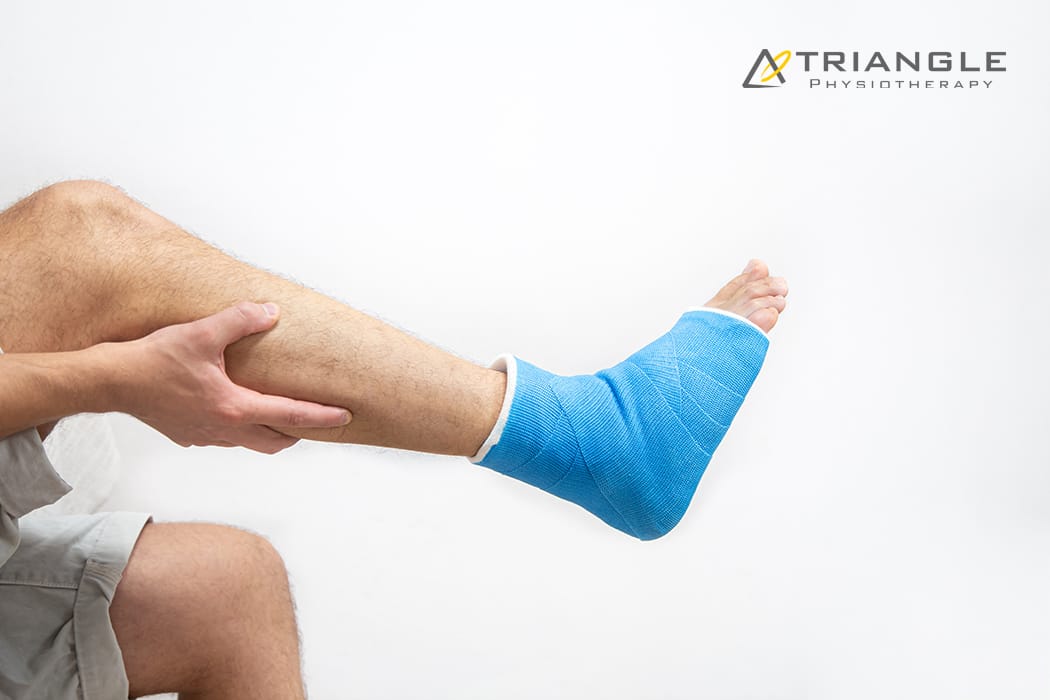Working from home has become the norm for many people, but with it comes a set of unique challenges— chief among them is the risk of developing musculoskeletal issues. Hours spent hunched over a laptop or sitting at a desk can lead to discomfort and pain, especially in the back, neck, and shoulders. To counteract these issues, incorporating simple stretches into your daily routine can be highly effective. This blog will explore how stretching and other physiotherapy principles can prevent and treat injuries, manage pain, and promote overall well-being.

Understanding the Injury
Before diving into the specifics of stretching, it’s crucial to understand why these injuries occur. Prolonged sitting and poor posture are common causes of discomfort for those working from home. These issues can lead to muscle strain, poor spinal alignment, and reduced flexibility. Typical symptoms include:
- Back Pain: Often due to poor posture or prolonged sitting.
- Neck Pain: Caused by leaning forward or poor desk ergonomics.
- Shoulder Pain: Often related to repetitive strain or poor posture.

Prevention and Treatment
Preventing injury is always better than treating it. Regular stretching and proper ergonomics can help keep your body in balance and reduce the risk of pain. However, if you do experience discomfort, addressing it early can prevent it from becoming a chronic issue.
Importance of Physiotherapy for Injury
Physiotherapy is vital for both preventing and treating musculoskeletal injuries. A physiotherapist can provide tailored exercises and stretches that target specific issues, helping to alleviate pain, improve posture, and enhance overall function. They use a combination of techniques, including manual therapy, exercise, and education, to treat and prevent injuries.
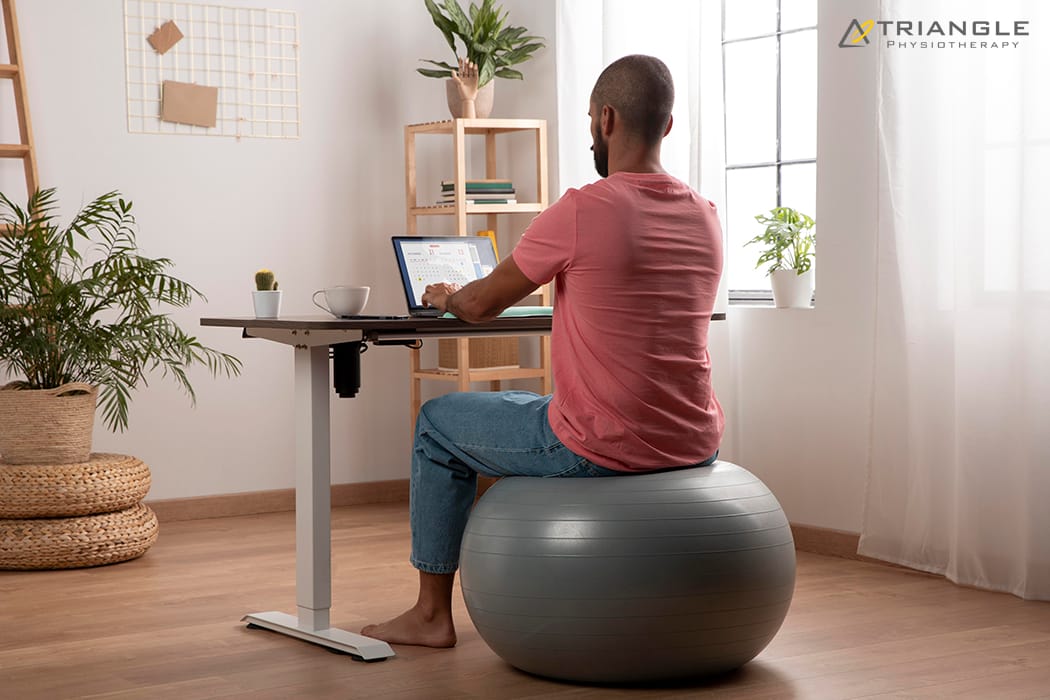
Key Principles of Physiotherapy Exercises for Pain Relief
- Personalization: Exercises should be tailored to your specific needs and injury.
- Gradual Progression: Start with basic exercises and gradually increase intensity.
- Consistency: Regular practice is essential for long-term relief and prevention.
- Proper Form: Ensuring correct technique is crucial to avoid further injury.
Strengthening Exercises
Strengthening the muscles around your back, neck, and shoulders can help support your spine and prevent pain. Here are a few key exercises to incorporate:
- Seated Rows: Using a resistance band or a machine, this exercise strengthens your upper back and shoulders. Sit with your back straight, pull the band or handle towards you, and squeeze your shoulder blades together.
- Wall Angels: Stand with your back against a wall and your arms raised to form a “W” shape. Slowly slide your arms up the wall to form a “Y,” then return to the starting position. This exercise helps improve shoulder mobility and posture.
- Bridges: Lie on your back with your knees bent and feet flat on the floor. Lift your hips towards the ceiling while squeezing your glutes and lower back muscles. This exercise strengthens your lower back and glutes, which can support your spine.
Neuromuscular Exercises for Pain Management and Prevention
Neuromuscular exercises focus on improving the connection between your brain and muscles, which can help with pain management and injury prevention:
- Core Stabilization: Planks and side planks strengthen your core, improving your body’s ability to support your spine. Hold each position for 20-30 seconds and gradually increase as you build strength.
- Pelvic Tilts: Lying on your back with your knees bent, flatten your lower back against the floor by tightening your abdominal muscles. This exercise helps improve lower back stability.
- Neck Retractions: Sit or stand with your back straight and gently pull your head back, tucking your chin towards your chest. This exercise can help relieve neck tension and improve posture.
Progressive Resistance Training
Progressive resistance training involves gradually increasing the weight or resistance you use during exercise. This type of training can enhance muscle strength and endurance, which is beneficial for injury prevention:
- Dumbbell Rows: Hold a dumbbell in one hand, place your other hand and knee on a bench for support, and pull the dumbbell towards your hip. This exercise targets your upper back and biceps.
- Shoulder Presses: Using dumbbells or a barbell, press the weights overhead while keeping your core engaged. This strengthens your shoulders and upper back.
- Single Leg Squat: To perform a single-leg squat, stand on one leg with your other leg extended slightly forward. Lower your body by bending your standing knee and pushing your hips back, keeping your torso upright. Lower as far as comfortable, then return to the starting position. Repeat on the other leg.
Incorporating Stretching and Flexibility Exercises in Your Routine
Incorporating stretching and flexibility exercises into your daily routine can greatly benefit your overall comfort and well-being:
- Neck Stretch: Gently tilt your head towards one shoulder, using your hand to apply light pressure. Hold for 20-30 seconds, then switch sides.
- Shoulder Stretch: Bring one arm across your chest and use the opposite arm to press it closer to your body. Hold for 20-30 seconds and switch arms.
- Back Stretch: Sit in a chair, cross one leg over the other, and twist your torso towards the top leg. Hold for 20-30 seconds and switch sides.
- Hip Flexor Stretch: Kneel on one knee with the other foot in front. Gently push your hips forward to stretch the front of your hip. Hold for 20-30 seconds and switch legs.
Working from home doesn’t have to come with a side of back and neck pain. By incorporating simple stretches and following key physiotherapy principles, you can prevent injuries, manage pain, and maintain overall comfort. Remember to personalize your exercises, progress gradually, and stay consistent. If you experience persistent discomfort, don’t hesitate to consult a physiotherapist to tailor a program to your specific needs. With the right approach, you can create a healthier, more comfortable home workspace.
Need advice on how to work from home without aches and pains? We can help!
Sitting for prolonged periods can cause many issues and create long term health problems.
Our team of expert physiotherapists in Mississauga are here to assist you in managing injuries or conditions that have reduced your ability to work comfortably from home without having pain and posture-related injuries.
Book an appointment with one of our physiotherapists in Mississauga today!
Low back pain is a common issue that many people face at some point in their lives. Whether it’s due to a sedentary lifestyle, poor posture, or an acute injury, it can be incredibly debilitating. While there are various treatments available, including medication and physical therapy, one of the most effective ways to manage and alleviate low back pain is through exercise. But not just any exercise—specific exercises can help strengthen your back, improve flexibility, and reduce discomfort.
So, what are the best exercises for low back pain? Let’s break it down into a few key categories and discuss some exercises that can be beneficial.

1. Core Strengthening Exercises
A strong core is essential for supporting your lower back. When your core muscles are weak, other muscles, including those in your back, have to work harder, which can lead to pain and discomfort. Here are a few core-strengthening exercises:
- Planks: This exercise targets your entire core. Start by lying face down and then lift your body up onto your elbows and toes. Keep your body in a straight line from head to heels. Hold this position for 20-30 seconds, gradually increasing the time as you get stronger.
- Bridges: Lie on your back with your knees bent and feet flat on the floor. Lift your hips towards the ceiling, squeezing your glutes at the top. Lower your hips back down slowly. Perform 10-15 repetitions.
- Bird Dogs: Start on your hands and knees. Extend one leg straight back while simultaneously reaching the opposite arm forward. Hold for a few seconds, then switch sides. Aim for 10-15 repetitions per side.
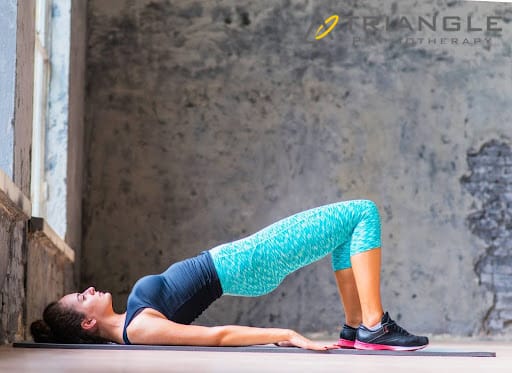
2. Flexibility and Stretching Exercises
Increasing flexibility can help alleviate tension in your lower back and improve your overall range of motion. Here are some stretches that can help:
- Child’s Pose: Kneel on the floor, then sit back on your heels and reach your arms forward on the floor, lowering your chest towards the ground. Hold this position for 20-30 seconds.
- Cat-Cow Stretch: Begin on your hands and knees. Arch your back upwards like a cat (Cat Pose), then dip your back down while lifting your head and tailbone towards the ceiling (Cow Pose). Repeat this sequence 10-15 times.
- Hamstring Stretch: Sit on the floor with one leg extended straight and the other bent so that the sole of the foot is against your inner thigh. Reach towards your extended foot while keeping your back straight. Hold for 20-30 seconds, then switch legs.
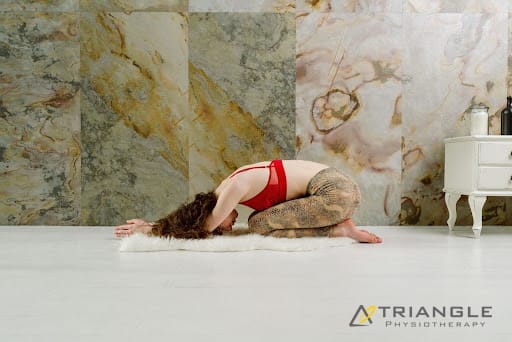
3. Strengthening Exercises for the Lower Back
Strengthening the muscles in your lower back can help support your spine and reduce pain. Here are a few exercises to consider:
- Supermans: Lie face down on the floor with your arms extended in front of you. Lift your arms, chest, and legs off the ground simultaneously, squeezing your lower back muscles. Hold for a few seconds, then lower back down. Perform 10-15 repetitions.
- Back Extensions: Lie face down with your hands by your sides or behind your head. Slowly lift your chest off the ground, keeping your legs and pelvis in contact with the floor. Hold for a few seconds before lowering back down. Aim for 10-15 repetitions.
- Pelvic Tilts: Lie on your back with your knees bent and feet flat on the floor. Flatten your lower back against the floor by tightening your abdominal muscles and tilting your pelvis upwards. Hold for a few seconds before relaxing. Perform 10-15 repetitions.
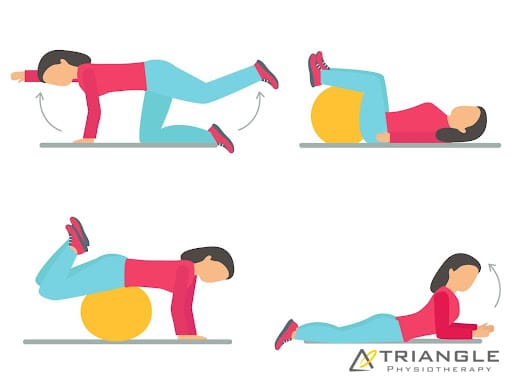
4. Low-Impact Aerobic Exercises
Aerobic exercise can improve blood flow to your back, promote healing, and enhance overall fitness. Low-impact exercises are particularly beneficial for those with back pain:
- Walking: Regular walking is a simple and effective way to get aerobic exercise without putting too much strain on your back. Aim for 20-30 minutes most days of the week.
- Swimming: Swimming provides a full-body workout while minimizing stress on the spine. The water’s buoyancy supports your body, allowing you to exercise without high-impact stress.
- Stationary Cycling: Using a stationary/recumbent bike can help improve cardiovascular fitness and strengthen the muscles around your lower back. Make sure the bike is properly adjusted to avoid strain.
5. Important Considerations
Before starting any new exercise routine, it’s important to consult with a healthcare professional, especially if you have chronic or severe back pain. They can help ensure that the exercises you choose are appropriate for your specific condition.
Additionally, when performing exercises for low back pain, focus on maintaining proper form and avoid movements that exacerbate your pain. Start slowly and gradually increase the intensity and duration of your workouts as you build strength and flexibility.
Incorporating the right exercises into your routine can be a game-changer for managing and reducing low back pain. Core strengthening, flexibility and stretching, lower back strengthening, and low-impact aerobic exercises all play a crucial role in alleviating discomfort and improving overall back health. Remember, consistency is key, and listening to your body is essential. With the right approach, you can find relief and improve your quality of life.
Are you ready to take control of your back pain? Book an appointment with one of our physiotherapists in Toronto or chiropractors in Toronto.
Our Downtown Toronto Physiotherapy Clinic is located conveniently in King West Village at 980 King Street West, Toronto, M6K 3N2 with free parking available.
Finding relief from low back pain often involves targeted exercises and professional guidance. If you’re seeking expert help, consider physiotherapy in Etobicoke, Oakville, North York, Toronto, Lawrence Park, Queens Quay, Erin Mills, Mississauga, or Liberty Village. Skilled physiotherapists in these locations can create a customized exercise plan to help you manage back pain and improve your quality of life.
Neck pain can disrupt daily life and hinder your ability to perform routine activities. Thankfully, Triangle Physiotherapy Oakville offers effective strategies to manage and prevent neck pain through a combination of neuromuscular exercises, progressive resistance training, stretching, and flexibility exercises. In this blog, we’ll explore the causes and symptoms of neck pain, the role of physiotherapy in treatment, and provide a comprehensive guide to various exercises and safety tips to help you find relief and maintain neck health.
Causes and Symptoms of Neck Pain
Neck pain often arises from:
- Poor Posture: Long hours of sitting with poor posture, especially while using a computer or smartphone, can lead to strain on neck muscles.
- Muscle Strain: Overuse or sudden movements can strain the neck muscles.
- Injuries: Trauma from accidents or sports can result in acute neck pain.
- Degenerative Conditions: Conditions like degenerative disc disease or herniated discs can contribute to chronic neck pain.
Common symptoms include:
- Stiffness: Difficulty in moving the neck or a feeling of tightness.
- Pain: Ranging from dull aches to sharp, shooting pain.
- Headaches: Often originating from the neck and radiating to the head
- Numbness or Tingling: Sensations that may radiate down the arms.
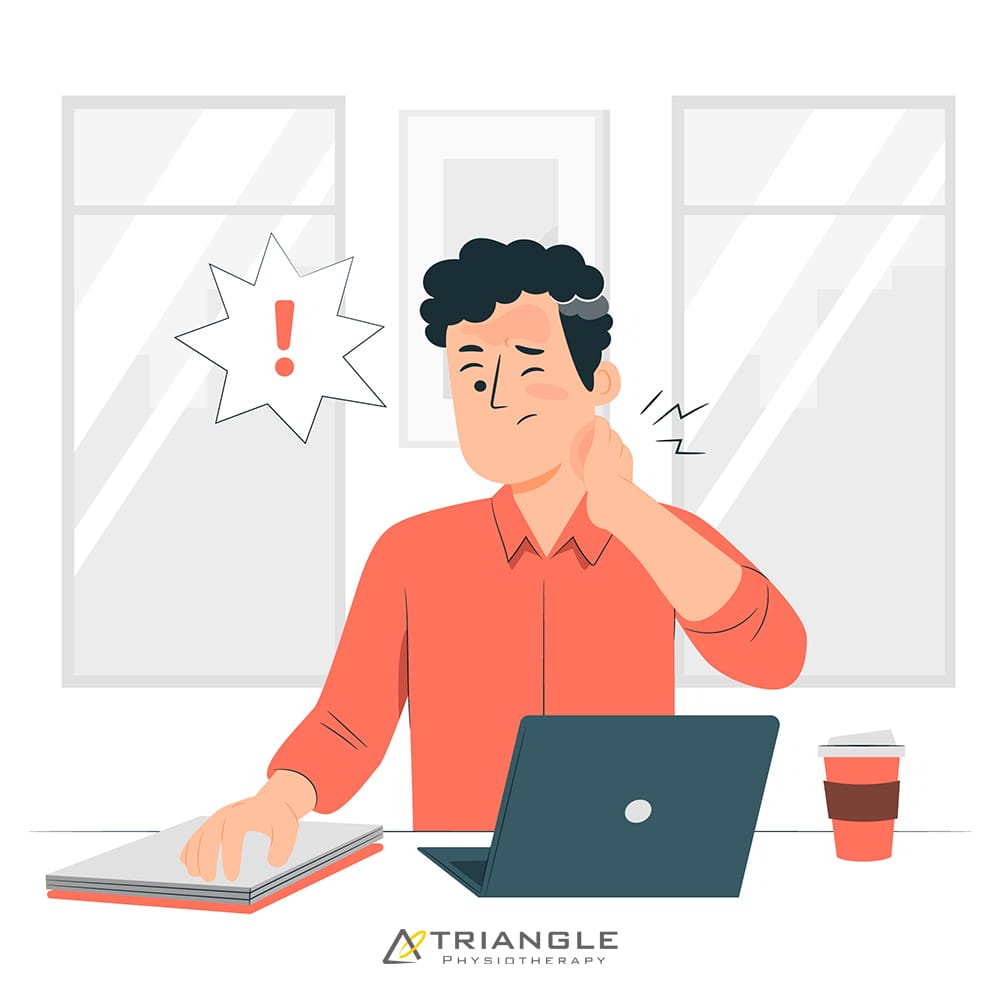
Importance of Physiotherapy in Neck Pain Management
Physiotherapy is vital for managing neck pain as it:
- Provides Personalized Treatment: A physiotherapist assesses your condition and crafts a tailored exercise program.
- Relieves Pain: Techniques and exercises can reduce pain and inflammation.
- Enhances Mobility: Improves flexibility and range of motion in the neck.
- Strengthens Muscles: Strengthening exercises help support the neck and prevent future issues.
- Corrects Posture: Guidance on ergonomics, help with brace selection and posture helps avoid recurrence.

Key Principles of Physiotherapy Exercises for Neck Pain Relief
- Gradual Progression: Start with gentle exercises and gradually increase intensity.
- Consistency: Regular exercise is crucial for ongoing relief.
- Proper Technique: Focus on correct form to prevent further injury.
- Balanced Approach: Incorporate stretching, strengthening, and stability exercises for comprehensive care.
Neuromuscular Exercises for Pain Management and Prevention
Neuromuscular exercises focus on improving the coordination and control of neck muscles, which can be beneficial for managing and preventing pain. These exercises enhance the communication between the nervous system and muscles, leading to better muscle function and reduced pain.
1. Cervical Stabilization Exercises:
- Isometric Neck Exercises:
- Front: Place your palm against your forehead and gently push your head into your hand without moving it. Hold for 5 seconds, then relax. Repeat 5-10 times.
- Sides: Place your hand on the side of your head and push against it while resisting movement. Hold for 5 seconds on each side.
- Deep Cervical Flexor Training:
- Chin Tucks: Sit or stand with your spine straight. Gently tuck your chin towards your chest and hold for 5-10 seconds. Repeat 10 times. This exercise strengthens deep neck flexors, which support the cervical spine. You may progress in this by using a blue/red (as per your comfort) resistance band at the occiput, holding with both hands and gently tucking your chin against the band. Hold 5-7 seconds, repeat 10 times.
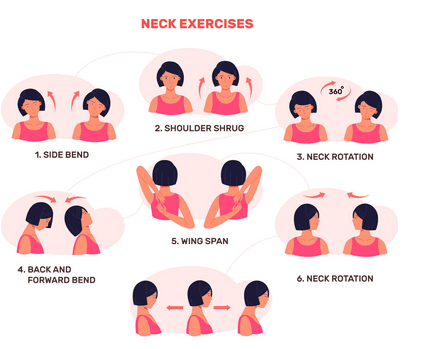
*Please note : neck rotation is never 360 degrees, it is only for illustration purposes. The last exercise is called a chin tuck. Avoid shoulder shrug without consulting a therapist.*
2. Proprioceptive Exercises:
This includes some movements of the arms as the nerves go down from your neck to the arms. Perform – circumduction, flexion and extension
Progressive Resistance Training for Neck Strength and Functionality
Progressive resistance training helps build strength and improve functionality in the neck muscles, which is essential for pain management and prevention.
1. Neck Resistance Exercises:
- Neck Flexion and Extension:
- Flexion: Sit upright and place your hands behind your head. Gently press your head into your hands while resisting the movement with your hands. Hold for 5 seconds and release. Repeat 10-15 times.
- Extension: Place your hands on your forehead and gently push your head back against your hands. Hold for 5 seconds and relax. Repeat 10-15 times.
- Lateral Flexion:
- Resistance Band Lateral Flexion: Secure a resistance band to a stable object. Hold the band with one hand and stand with the band on the side of your head. Tilt your head away from the band, using the resistance to strengthen the lateral neck muscles. Perform 10-15 repetitions on each side.
- Incorporating Stretching and Flexibility Exercises into Your Routine
- Stretching and flexibility exercises are crucial for maintaining a healthy range of motion and preventing neck stiffness.
- Upper Trapezius Stretch:
- Levator Scapulae Stretch:
- Sit upright and turn your head to one side while looking down towards your armpit. Use your hand to gently press your head into the stretch. Hold for 15-30 seconds and then switch sides.
- Pectoralis Minor Stretch : To stretch the pectoralis minor, place your arm at shoulder height against a wall. Rotate your torso away from the wall gently, feeling the stretch in your chest and shoulder. Hold for 20-30 seconds, then switch sides. Keep shoulders relaxed and avoid pain. Regular stretching improves flexibility.
Tips for Safely Performing Physiotherapy Exercises for Neck Pain in Oakville
- Warm-Up: Always start with a gentle warm-up to prepare your muscles and reduce the risk of injury.
- Listen to Your Body: If an exercise causes pain or discomfort beyond mild stretching, stop and consult your physiotherapist.
- Avoid Overexertion: Progress gradually and avoid pushing yourself too hard.
- Maintain Good Posture: Ensure that you are performing exercises with proper posture to avoid straining other muscles.
- Stay Hydrated: Drink plenty of water to keep your muscles hydrated and aid recovery.
What do I do next?
Don’t let these physical conditions ever ride on you. Book an Appointment at Triangle Physiotherapy Oakville or simply Book An Appointment online.
“For those seeking relief from neck pain, Triangle Physiotherapy offers expert services at multiple locations including Etobicoke, Oakville, North York, Toronto, Lawrence Park, Queens Quay, Erin Mills, Mississauga, and Liberty Village.”
Breastfeeding can be a fulfilling and bonding experience, but it sometimes comes with challenges such as mastitis and blocked milk ducts. These conditions can be painful and stressful for new mothers, but understanding and managing them can significantly improve your breastfeeding journey. In this blog, we’ll explore what mastitis and blocked milk ducts are, their symptoms, causes, and how physiotherapy, particularly in the pelvic health domain, can help. This information is especially valuable for mothers in North York looking for local resources and support.
What is Mastitis?
Mastitis is an inflammation of breast tissue that often involves an infection. This condition can cause breast pain, swelling, warmth, and redness. In some cases, mothers might experience fever and chills. It typically occurs in breastfeeding women when milk ducts become blocked or when bacteria enter the breast through a cracked nipple.
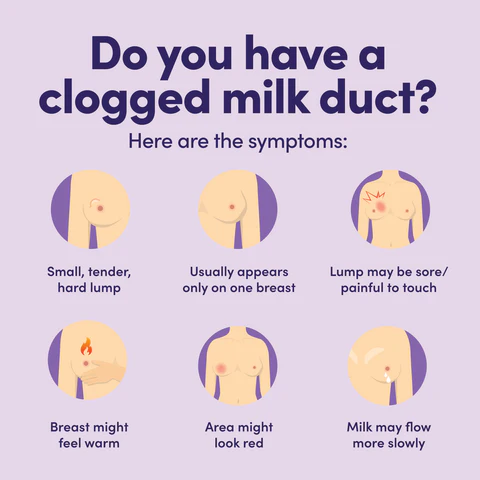
Symptoms of Mastitis
Common symptoms of mastitis include:
- Breast pain or tenderness
- Swelling and warmth in the affected area
- Redness, often in a wedge-shaped pattern
- Fever and chills
- Fatigue
Causes of Mastitis
Mastitis is often caused by:
- Blocked milk ducts: When milk isn’t fully drained from the breast, it can cause a blockage, leading to inflammation.
- Bacterial infection: Bacteria from the baby’s mouth or the mother’s skin can enter the breast through a cracked nipple.
Understanding Blocked Milk Ducts
Blocked milk ducts are a common issue for breastfeeding mothers. When a duct is blocked, it prevents the milk from flowing freely through the breast, leading to a backup of milk and potential inflammation.
Symptoms of Blocked Milk Ducts
- A small, hard lump in the breast that may be tender to the touch
- Discomfort or pain in one area of the breast
- A decrease in milk supply from the affected breast
- Milk blebs or blisters on the nipple
Causes of Blocked Milk Ducts
- Infrequent breastfeeding or pumping
- Poor latch or ineffective sucking by the baby
- Pressure on the breast from tight clothing or a poorly fitting bra
- Stress and fatigue
How Physiotherapy Can Help
Physiotherapy can be an effective treatment for mastitis and blocked milk ducts. Specialized techniques used by physiotherapists in the pelvic health domain can alleviate symptoms and prevent recurrence. Here are some ways physiotherapy can help:
Therapeutic Ultrasound
Therapeutic ultrasound is a non-invasive treatment that uses sound waves to reduce inflammation and pain. It can help to clear blocked ducts and promote milk flow.
Breast Massage Techniques
Our Physiotherapists in North York can teach you proper breast massage techniques to relieve blocked ducts. This includes:
- Gentle circular motions around the lump
- Moving the lump towards the nipple
- Massage before and during breastfeeding to aid milk flow
Education and Support
Our Physiotherapists in North York provide education on proper breastfeeding techniques, ensuring a good latch and advising on optimal breastfeeding positions. They also offer support and strategies to manage stress and fatigue, which are crucial for overall well-being.
Local Resources in North York
For mothers in North York, Triangle Physiotherapy North York specializes in pelvic health and offers targeted treatments for breastfeeding-related issues. Our clinic provides a supportive environment where mothers can receive personalized care and practical advice.
Prevention Tips
Preventing mastitis and blocked milk ducts involves:
- Frequent breastfeeding or pumping to keep the milk flowing
- Ensuring the baby has a good latch
- Varying breastfeeding positions
- Wearing loose-fitting, comfortable bras
- Staying hydrated and maintaining a balanced diet
Mastitis and blocked milk ducts can be challenging, but with the right understanding and support, they are manageable. Physiotherapy offers effective treatments and strategies to help mothers overcome these issues and continue their breastfeeding journey with confidence. If you’re in North York and experiencing breastfeeding challenges, consider reaching out to a local pelvic health physiotherapist for specialized care.
For more information or to book an appointment, contact our clinic today and take the first step towards a pain-free breastfeeding experience.
“For those dealing with mastitis or blocked milk ducts, Triangle Physiotherapy provides expert care across various locations including Etobicoke, Oakville, North York, Toronto, Lawrence Park, Queens Quay, Erin Mills, Mississauga, and Liberty Village.”
Managing mastitis and blocked milk ducts can be challenging, but with the right care, recovery is possible. For comprehensive support, consider physiotherapy in Etobicoke, Oakville, North York, Toronto, Lawrence Park, Queens Quay, Erin Mills, Mississauga, or Liberty Village. Skilled physiotherapists in these areas can help you manage symptoms effectively and promote healing.
Pregnancy is a remarkable journey filled with joy and anticipation. However, it also brings various physical challenges, one of the most common being back pain. This blog explores the causes of pregnancy back pain and how physiotherapy can provide relief. We’ll delve into the benefits of pelvic health physiotherapy in Mississauga and the holistic approach it offers to expecting mothers.

Causes of Pregnancy Back Pain
Hormonal Changes
During pregnancy, the body produces a hormone called relaxin, which helps to loosen the ligaments in the pelvic area to prepare for childbirth. While necessary, this increased flexibility can lead to instability and back pain.
Weight Gain
The additional weight gained during pregnancy puts extra strain on the spine. This added pressure can cause discomfort and pain, particularly in the lower back.
Postural Changes
As the baby grows, the center of gravity shifts forward, leading to changes in posture. This can result in muscle strain and back pain as the body adjusts to the new alignment.
Stress
Emotional stress can cause muscle tension in the back, leading to pain. It’s essential to manage stress effectively during pregnancy to minimize its impact on physical health.
How Physiotherapy Can Help with Pregnancy Back Pain
Personalized Treatment Plans
Physiotherapy in Mississauga offers personalized treatment plans tailored to the specific needs of pregnant women. These plans focus on alleviating back pain through targeted exercises and techniques.
Pain Relief Techniques
Physiotherapists use a variety of techniques to relieve pregnancy back pain, including manual therapy, massage, and specific exercises designed to strengthen the back and core muscles.
Pelvic Health Physio in Mississauga
Pelvic health physiotherapy is a specialized branch of physiotherapy that focuses on the pelvic floor muscles, which play a crucial role during pregnancy and childbirth. Pelvic health physiotherapists in Mississauga helps in:
- Strengthening Pelvic Floor Muscles: Exercises to enhance the strength and function of these muscles.
- Improving Posture: Guidance on maintaining proper posture to reduce back strain.
- Breathing Techniques: Techniques to manage pain and improve overall comfort during pregnancy.
Benefits of Physiotherapy for Pregnancy Back Pain
Reducing Pain and Discomfort
Regular physiotherapy sessions can significantly reduce back pain and discomfort, improving the quality of life for expecting mothers.
Enhancing Mobility
Physiotherapy helps maintain and improve mobility, making daily activities easier and more comfortable.
Preparing for Childbirth
Pelvic physio in Mississauga not only alleviates back pain but also prepares the body for childbirth by strengthening the pelvic floor muscles and improving overall physical readiness.
Postpartum Recovery
Physiotherapy continues to be beneficial postpartum, aiding in the recovery process and helping new mothers regain their strength and mobility.
What do I do next?
Find the Right Physiotherapist in Mississauga
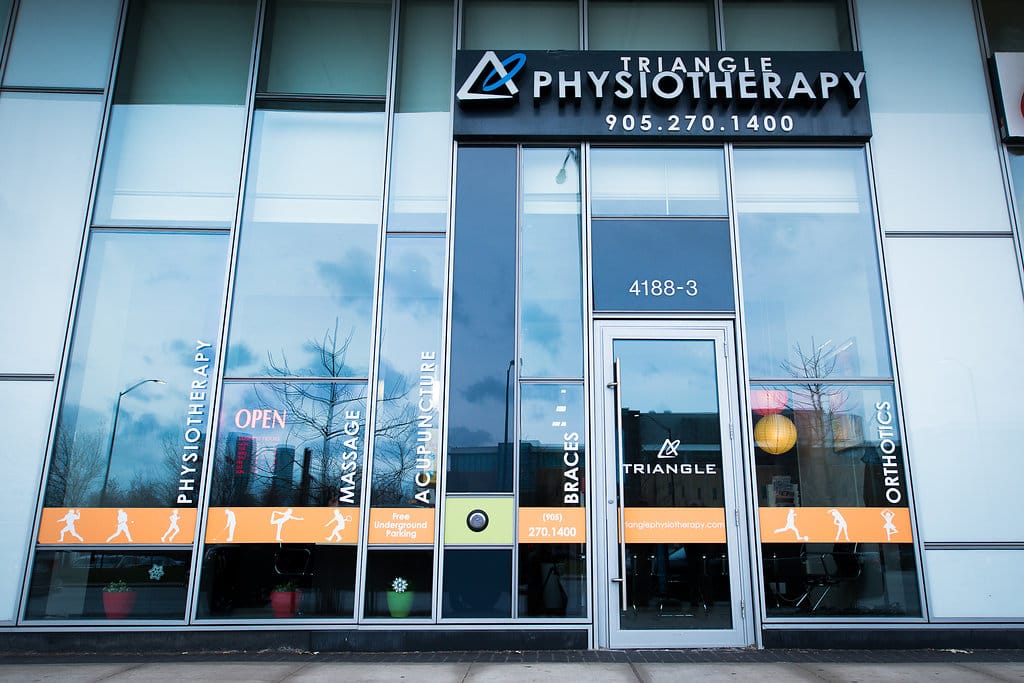

When looking for physiotherapy in Mississauga, it’s essential to find a qualified and experienced physiotherapist who specializes in pregnancy and pelvic health. Our Locations in Mississauga have trained and experienced pelvic health physiotherapists with advanced training in pelvic health including Labour and Delivery Prep.
Pregnancy back pain is a common but manageable condition. With the right approach, such as physiotherapy in Mississauga, expecting mothers can find relief and improve their overall well-being. Pelvic health physiotherapists at Triangle Physiotherapy in Mississauga offers specialized care that addresses the unique challenges of pregnancy, providing a holistic approach to pain management and preparation for childbirth. By incorporating physiotherapy into their prenatal care routine, pregnant women can enjoy a more comfortable and healthy pregnancy journey.
Triangle Physiotherapy has 2 locations in Mississauga to help you with your pregnancy-related back pain:
Triangle Physiotherapy Square One
Triangle Physiotherapy Erin Mills
“At Triangle Physiotherapy, we have multiple locations across the GTA, including Physiotherapy in Etobicoke, Oakville, North York, Toronto, Lawrence Park, Queens Quay, Erin Mills, Mississauga, and Liberty Village. Our clinics are dedicated to providing specialized care for pregnancy-related back pain, ensuring that every expecting mother receives the best possible treatment.”
Hiking is a wonderful way to explore nature and stay active, but it’s not without its risks. Understanding common hiking injuries, their causes, symptoms, and effective prevention strategies can make your outdoor adventures safer and more enjoyable. Here’s a comprehensive guide to help you stay injury-free on the trails.
Understanding Hiking Related Injuries
Hiking can lead to various injuries, often related to the terrain, equipment, or physical condition of the hiker. Common hiking injuries include:
- Sprained Ankles: Caused by uneven ground, rocks, or roots.
- Knee Injuries: Such as patellar tendonitis or meniscus tears from repetitive strain.
- Muscle Strains: Typically in the calves, thighs, or lower back due to overexertion.
- Blisters and Hotspots: Resulting from friction and poorly fitting footwear.
- Sunburn and Heat Exhaustion: Due to prolonged exposure to the sun and inadequate hydration.
- Back Injuries: Resulting from improper lifting of heavy backpacks or poor posture.
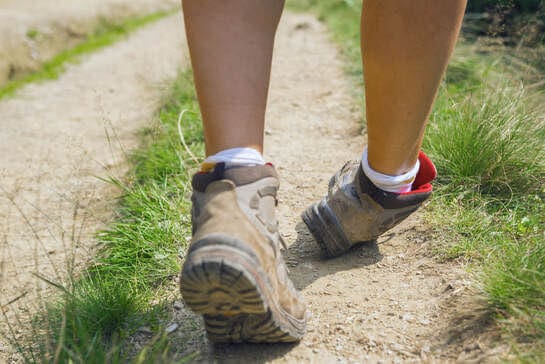
Causes and Symptoms
Each type of injury has specific causes and symptoms:
- Sprained Ankles: Twisting the ankle on unstable ground, causing pain, swelling, and difficulty walking.
- Knee Injuries: Overuse, sudden twists, or impacts leading to pain, swelling, and limited mobility.
- Muscle Strains: Overstretching or overloading muscles, resulting in pain, stiffness, and reduced range of motion.
- Blisters and Hotspots: Friction from ill-fitting socks or boots causing painful, fluid-filled sacs on the skin.
- Sunburn and Heat Exhaustion: Excessive sun exposure leading to red, painful skin, dehydration, dizziness, and nausea.
- Back Injuries: Lifting heavy loads improperly, causing pain, stiffness, or spasms in the lower back.
Importance of Physiotherapy for Hiking Injuries
Physiotherapy plays a crucial role in treating hiking injuries by promoting recovery, restoring mobility, and preventing future problems. Benefits include:
- Pain Relief: Through targeted exercises and techniques.
- Restoration of Mobility: Enhancing flexibility and range of motion.
- Improvement in Strength: Strengthening muscles to support injured areas.
- Prevention of Recurrence: Teaching proper movement patterns and injury prevention strategies.
Key Principles of Physiotherapy Exercises for Pain Relief
Physiotherapy exercises focus on alleviating pain and promoting healing:
- Stretching and Range of Motion Exercises: Improve flexibility and joint function.
- Proprioception Training: Enhance balance and stability to prevent re-injury.
- Manual Therapy: Techniques such as massage or joint mobilization to reduce pain and inflammation.
Strengthening Exercises
Building strength is essential for recovery and injury prevention:
- Core Strengthening: Supports the back and improves posture.
- Lower Body Exercises: Target muscles in the legs and hips for stability.
- Resistance Training: Uses bands or weights to strengthen specific muscle groups.
Neuromuscular Exercises for Pain Management and Prevention
These exercises improve coordination and control:
- Balance Exercises: Enhance stability on uneven terrain.
- Functional Movements: Mimic hiking motions to improve efficiency and reduce strain.
Progressive Resistance Training
Gradually increasing resistance builds strength:
- Incremental Loading: Challenges muscles without causing undue stress.
- Specificity: Tailors exercises to mimic hiking movements and demands.
Incorporating Stretching and Flexibility Exercises in Your Routine
Regular stretching maintains muscle elasticity and joint flexibility:
- Pre-hike Stretching: Warms up muscles and prepares them for activity.
- Post-hike Stretching: Helps muscles recover and prevents stiffness.
Tips for Safely Performing Physiotherapy Exercises
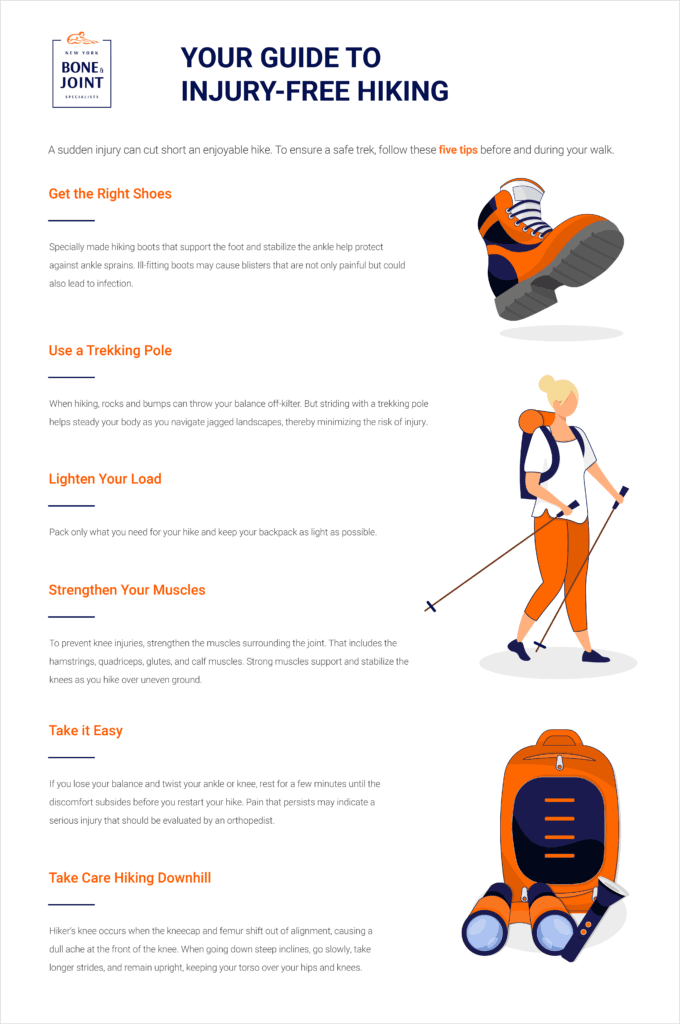
Follow these guidelines to avoid further injury:
- Consult a Professional: Get a personalized exercise plan from a physiotherapist.
- Start Gradually: Increase intensity and duration of exercises as tolerated.
- Listen to Your Body: Stop if you feel pain beyond normal discomfort.
- Stay Consistent: Perform exercises regularly for best results.
Hiking injuries can be prevented and managed effectively with the right knowledge and preparation. By understanding the causes, symptoms, and treatment options for common hiking injuries, along with incorporating physiotherapy exercises into your routine, you can enjoy the trails safely and confidently. Remember, safety and preparation are key to a rewarding hiking experience—happy trails!
Conclusion
Don’t let these physical conditions ever ride on you. You can consult any of our locations of Triangle Physiotherapy or simply Book An Appointment online.
“Whether you’re dealing with hiking-related injuries or any other physical discomfort, Triangle Physiotherapy offers expert care at multiple locations across the GTA. Our clinics provide Physiotherapy in Etobicoke, Oakville, North York, Toronto, Lawrence Park, Queens Quay, Erin Mills, Mississauga, and Liberty Village. Visit us to receive tailored treatment that helps you get back on your feet and enjoy the activities you love.”
Carpal tunnel syndrome (CTS) is a common condition that affects many individuals, often causing pain, numbness, and tingling in the hand and arm. If you’ve undergone carpal tunnel decompression surgery to alleviate these symptoms, you might be wondering about the next steps in your recovery journey.
One crucial aspect of postoperative care is physiotherapy. In this blog post, we’ll explore how physiotherapy can aid in your recovery after carpal tunnel surgery and what you can expect from the process, especially if you’re seeking physiotherapy in Oakville.
Understanding Carpal Tunnel Decompression Surgery
What is Carpal Tunnel Syndrome?
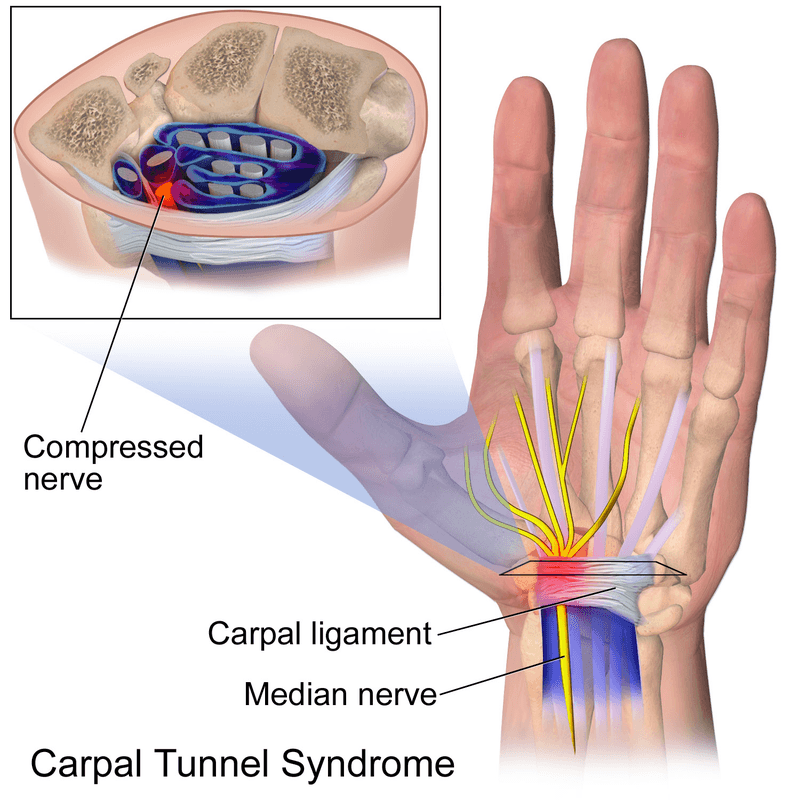
Carpal tunnel syndrome occurs when the median nerve, which runs from the forearm into the palm of the hand, becomes compressed at the wrist. This can result from various factors, including repetitive hand movements, wrist anatomy, or underlying health conditions.
Surgical Intervention
When conservative treatments like splinting, anti-inflammatory medications, or steroid injections fail to relieve symptoms, carpal tunnel surgery might be recommended. The procedure involves cutting the ligament that is pressing on the median nerve, thereby reducing pressure and alleviating symptoms.
The Role of Physiotherapy in Recovery
Initial Post-Surgery Phase
Immediately after surgery, the focus is on wound care, pain management, and preventing infection. During this period, your wrist and hand might be immobilized to promote healing. Physiotherapy often begins shortly after this initial phase.
Benefits of Physiotherapy
- Pain Relief: Physiotherapy can help manage postoperative pain through various techniques such as manual therapy, ice application, and ultrasound therapy.
- Reducing Swelling: Techniques like lymphatic drainage and specific exercises can help reduce swelling in the wrist and hand.
- Restoring Mobility: Gentle exercises and stretches are introduced to restore the range of motion in the wrist and fingers.
- Strengthening Muscles: Gradual strengthening exercises are crucial to rebuild the muscles weakened by surgery and inactivity.
- Scar Management: Physiotherapists can use techniques to minimize scar tissue formation and improve the flexibility of the scar.
- Functionality Restoration: The ultimate goal is to help you return to your normal daily activities without pain or limitation.

Typical Physiotherapy Regimen
- Assessment: Your physiotherapist will assess your specific condition, including the range of motion, strength, pain levels, and any functional limitations.
- Custom Exercise Program: Based on the assessment, a tailored exercise program will be designed. This may include:
- Range of Motion Exercises: Gentle stretching to improve flexibility.
- Strengthening Exercises: Using resistance bands or light weights to strengthen hand and wrist muscles.
- Nerve Gliding Exercises: To enhance the mobility of the median nerve.
- Manual Therapy: Hands-on techniques to mobilize joints and soft tissues, reduce pain, and improve function.
- Education: Learning about ergonomics and proper hand use to prevent recurrence or further injury.
Physiotherapy in Oakville
If you are based in Oakville, you have access to a range of skilled physiotherapists who can guide you through your recovery. Triangle Physiotherapy in Oakville is known for its comprehensive and patient-centered approach, ensuring that each individual receives personalized care tailored to their specific needs.
Triangle Physiotherapy in Oakville emphasizes the importance of a tailored exercise program, which includes range of motion exercises, strengthening routines, and nerve gliding techniques. The physiotherapists here are experienced in scar management and manual therapy, ensuring a holistic approach to your recovery.
How Long Will Physiotherapy Last?
The duration of physiotherapy varies depending on the severity of your condition, the extent of the surgery, and your individual response to treatment. On average, patients may undergo physiotherapy for several weeks to a few months. Regular follow-up sessions will track progress and adjust the treatment plan as needed.
Get started on your journey to recovery with the help of our talented physiotherapists in Oakville.
At Triangle Physiotherapy in Oakville, our team is skilled in evaluating each person’s unique needs to create a customized treatment plan. We ensure that your physiotherapy program provides comprehensive care, addressing all possible issues.
Call us at 905.257.3334 to book an appointment or request an appointment online HERE.
“After carpal tunnel surgery, it’s important to receive the right rehabilitation care. Triangle Physiotherapy is here to help you recover with specialized services across the GTA. Our clinics offer Physiotherapy in Etobicoke, Oakville, North York, Toronto, Lawrence Park, Queens Quay, Erin Mills, Mississauga, and Liberty Village. Let our expert team guide you through your post-surgery recovery for the best possible outcomes.”
If you have had achilles tendon repair surgery or are scheduled for a procedure, you are likely going to need post-surgery rehabilitation to recover completely. It is also advisable to do physiotherapy pre-surgery to maximize the outcomes of the surgery. This is also known as prehab or pre-surgery rehab. At Triangle Physiotherapy, our physiotherapists are skilled and experienced at helping their patients reach their optimal level of recovery. If you’re looking for expert guidance in post-surgery rehab near you or post-operative physiotherapy in Toronto, you’ve come to the right place.
Achilles tendon injuries are common, particularly among athletes and active individuals. The Achilles tendon, the largest and strongest tendon in the body, connects the calf muscles to the heel bone, playing a crucial role in walking, running, and jumping. When this tendon is torn or ruptured, Achilles repair surgery is often necessary. However, surgery is only the first step toward recovery. Effective rehabilitation is essential for restoring function, strength, and mobility. In this blog, we’ll guide you through the stages of Achilles repair surgery rehab, providing insights and tips to ensure a successful recovery.
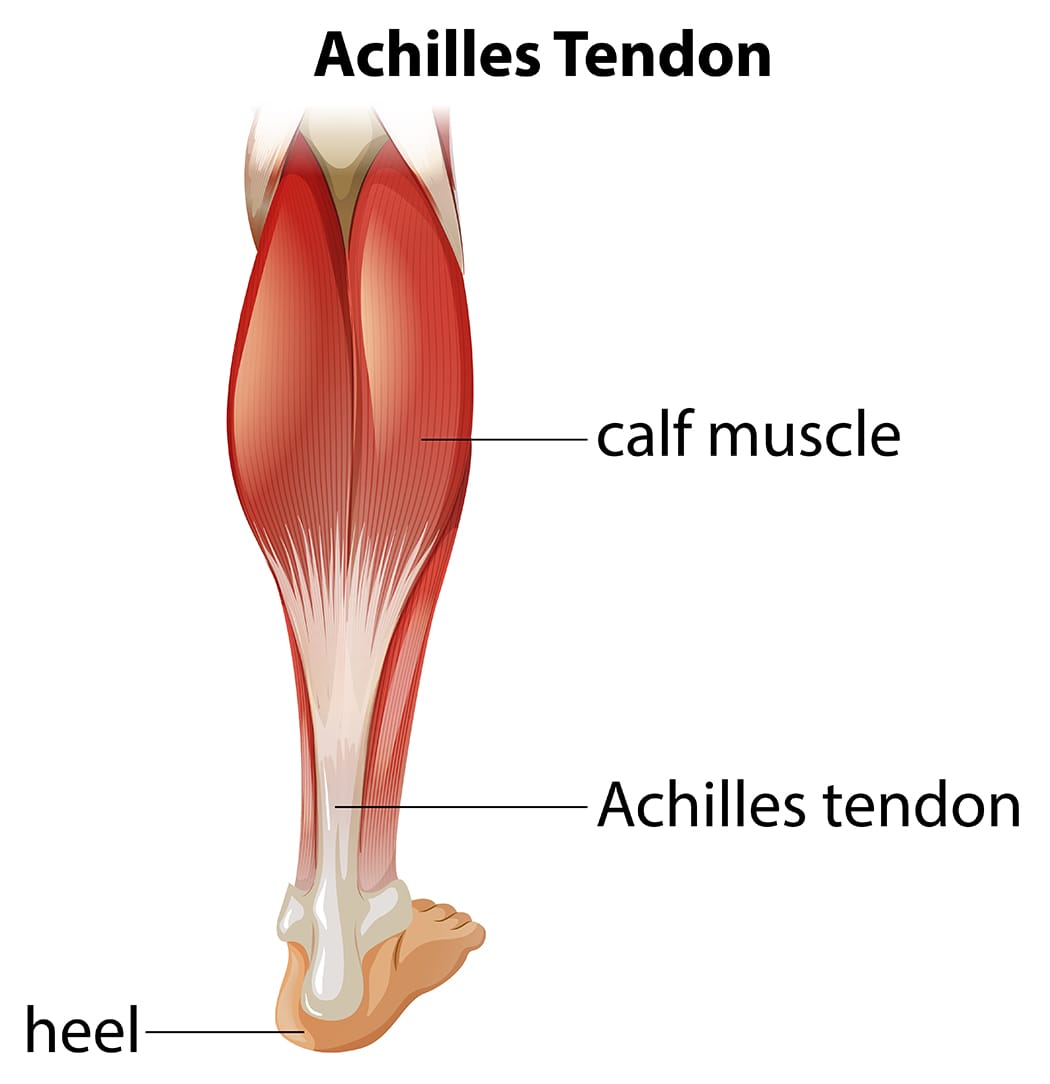
Understanding Achilles Tendon Injuries
What is the Achilles Tendon?
The Achilles tendon is a band of fibrous tissue that links the calf muscles to the heel bone. It enables activities that involve pushing off the foot, such as running and jumping.
Common Causes of Achilles Tendon Injuries
- Overuse: Repetitive stress from activities like running can lead to micro-tears.
- Sudden Increase in Activity: Rapid changes in activity levels can strain the tendon.
- Trauma: Direct impact or sudden, forceful movement can cause a rupture.
- Age and Degeneration: As people age, tendons become less flexible and more prone to injury.
Achilles Repair Surgery
Goals of Surgery
- Reattach the torn ends of the tendon.
- Restore the tendon’s length and tension.
- Enable the patient to return to their pre-injury level of activity.
Tips for a Successful Rehab
- Consistency: Adhere to the rehab program and attend all physiotherapy sessions.
- Listen to Your Body: Avoid pushing through pain; inform your therapist of any discomfort.
- Nutrition: Maintain a balanced diet to support tissue repair and overall health.
- Patience: Recovery takes time; focus on gradual progress rather than rushing the process.
Rehabilitating after Achilles repair surgery is a structured and multi-phased process that requires dedication and guidance from skilled physiotherapists. At Triangle Physiotherapy, we are committed to providing personalized rehabilitation programs to ensure our patients achieve optimal recovery and return to their active lifestyles. If you’ve undergone Achilles repair surgery or are scheduled for one, contact us to learn how our expert team can support you through every step of your recovery journey.
For those searching for physiotherapy in Toronto, post-surgery rehab in Toronto, or post-operative physiotherapy in Toronto, we offer comprehensive services tailored to your needs.
For more information or to schedule an appointment, or call us at 416.203.8622. Let us help you get back on your feet stronger and healthier.
“Recovering from Achilles repair surgery requires expert care and guidance. Triangle Physiotherapy offers comprehensive rehabilitation services at several locations across the GTA. Visit our clinics for Physiotherapy in Etobicoke, Oakville, North York, Toronto, Lawrence Park, Queens Quay, Erin Mills, Mississauga, and Liberty Village to ensure a smooth and effective recovery journey with the help of our specialized physiotherapy team.”
Vaginal atrophy, also known as atrophic vaginitis, is a condition that many women experience, especially after menopause. It involves changes in the vaginal area that can cause discomfort and other symptoms. Fortunately, our pelvic health physiotherapists in North York can help manage these symptoms and improve your quality of life.
What is Vaginal Atrophy?
Vaginal atrophy often happens during menopause when the levels of estrogen, a hormone in a woman’s body, decrease. When this happens, it can lead to:
- Dryness: The vagina becomes less moist, leading to dryness and irritation.
- Thinning of Vaginal Walls: The walls of the vagina become thinner and less flexible.
- Inflammation and Redness: The vaginal area can become inflamed and red, causing pain.
- Urinary Symptoms: You might experience more frequent urination, a strong urge to urinate, or urinary tract infections (UTIs).
These changes can make everyday activities uncomfortable and affect your sex life.
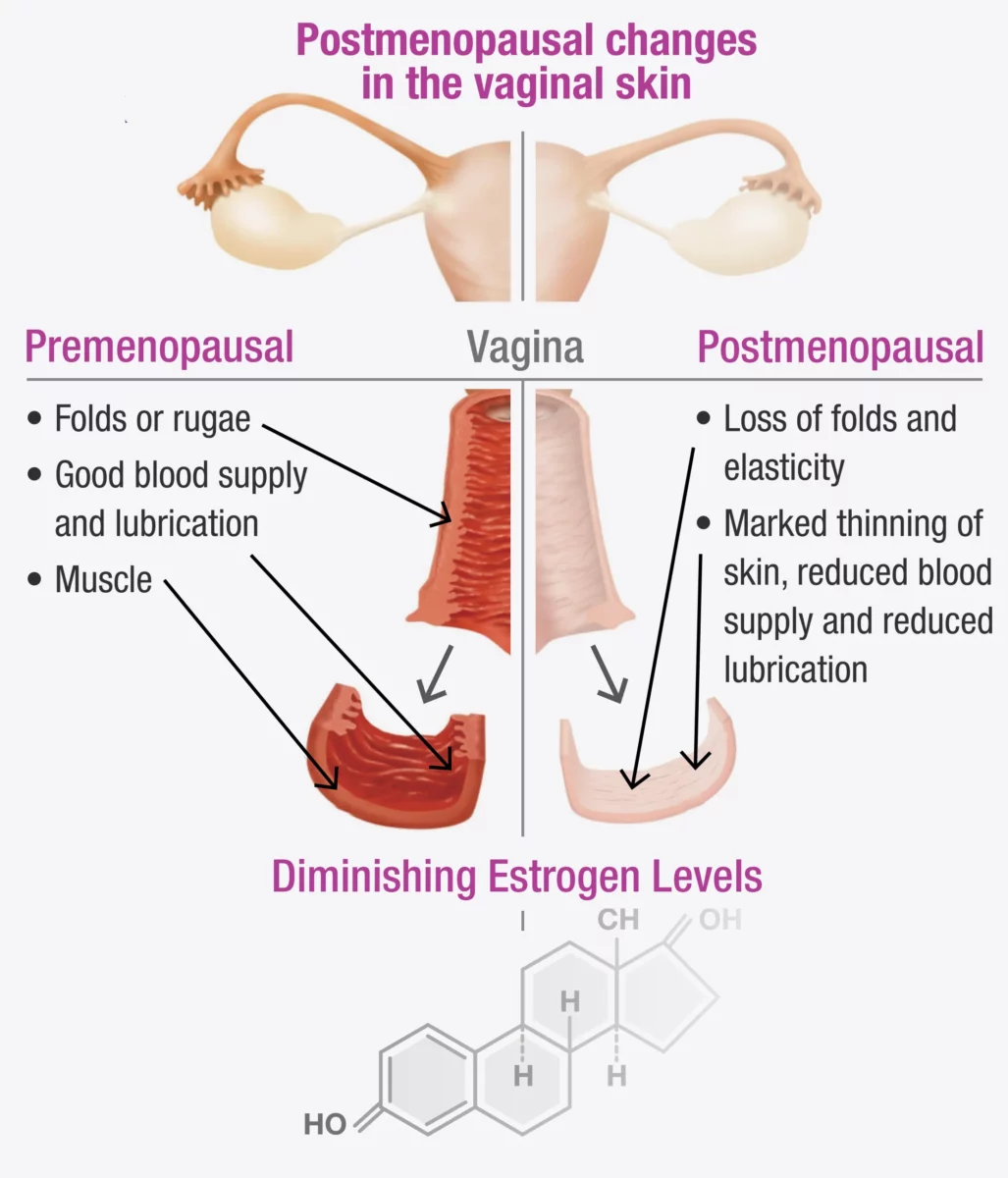
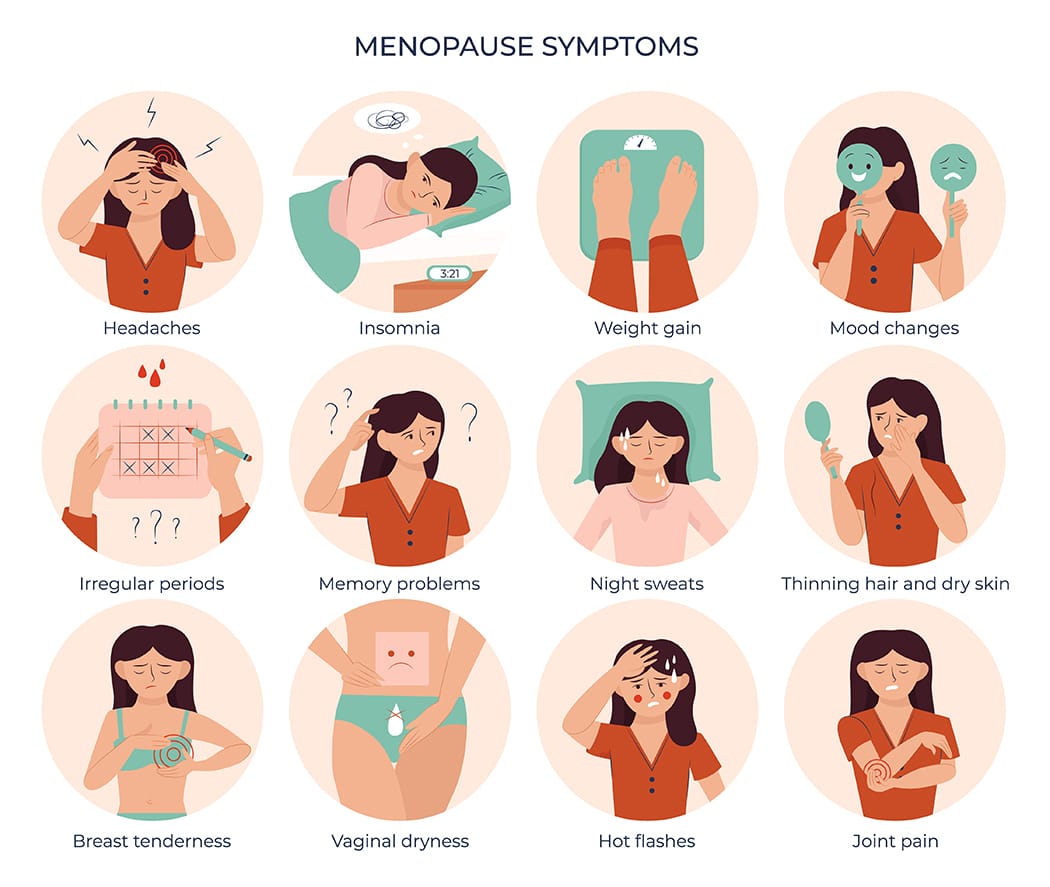
If vaginal atrophy is not treated and a woman continues to experience painful intercourse, the vaginal muscles may react by tightening to protect the body. Over time, this tightening can become an automatic response (vaginismus) that continues even after the atrophy has been treated.
Fortunately, both conditions can be treated with the help of a pelvic health Physiotherapist in North York. In fact, it is often necessary to treat vaginal atrophy and vaginismus together, as addressing one without the other can be challenging.
Symptoms to Watch For
You might have vaginal atrophy if you notice:
- Pain During Sex: Painful intercourse (called dyspareunia) is a common symptom.
- Itching or Burning: These sensations can be uncomfortable and persistent.
- Frequent UTIs: More urinary tract infections than usual.
- Vaginal Bleeding or Discharge: Unusual bleeding or discharge can occur.
- Difficulty Urinating: Problems with urination, such as a strong urge or pain.
Recognizing these symptoms early can help you get the treatment you need sooner.
How a Pelvic Health Physiotherapist Can Help with Menopause and Vaginal Atrophy
A pelvic health physiotherapist is a specialist who focuses on the muscles and tissues in the pelvic area. They can provide various treatments to help manage vaginal atrophy. Here’s how they can assist:
1. Assessment and Diagnosis
The first step is a thorough check-up, which includes:
- Reviewing Your Medical History: Discussing your symptoms, medical history, and any medications you are taking.
- Physical Examination: Checking the condition of your vaginal walls, pelvic floor muscles, and surrounding tissues.
2. Customized Exercise Programs
These physiotherapists create specific exercise programs to strengthen and relax your pelvic floor muscles. These exercises can:
- Improve Muscle Tone: Making the vaginal muscles stronger and more flexible.
- Boost Blood Flow: Increasing circulation to help with healing and tissue health.
3. Manual Therapy and Techniques
Hands-on techniques are used to improve the flexibility and function of your pelvic area, such as:
- Myofascial Release: Reducing tension in the pelvic muscles.
- Scar Tissue Mobilization: Addressing any scarring or adhesions in the vaginal area.
4. Education and Lifestyle Advice for Menopause
Education is a key part of therapy, including advice on:
- Diet and Hydration: Eating a balanced diet and staying hydrated for overall health.
- Relaxation Techniques: Learning how to relax your pelvic floor muscles to reduce discomfort.
5. Use of Devices and Modalities
They might suggest using certain devices and techniques, such as:
- Vaginal Dilators: These help gently stretch the vaginal walls, making them more flexible.
- Electrostimulation: Using mild electrical impulses to strengthen pelvic muscles.
How do I find a pelvic health physiotherapist in North York?
We have 8 locations with pelvic health physiotherapists to help you. If you are going through menopause and are seeing signs of vaginal atrophy, Book an Appointment today!
Pelvic Health Physiotherapists in North York:
- Pelvic Health Physiotherapy North York – Triangle Physiotherapy North York
- Uptown Toronto Pelvic Health – Triangle Physiotherapy Lawrence Park
At Triangle Physiotherapy, we understand that conditions like menopause and vaginal atrophy can significantly impact your quality of life. Our team of experienced professionals is here to help you through specialized physiotherapy treatments designed to address these and other related concerns. Whether you’re seeking Physiotherapy in Etobicoke, Physiotherapy in Oakville, Physiotherapy in North York, or Physiotherapy in Toronto, we have clinics conveniently located across the region. Visit us at Physiotherapy Lawrence Park, Physiotherapy Clinic Queens Quay, Physiotherapy Erin Mills, Physiotherapy Mississauga, or Physiotherapy Liberty Village to start your journey towards better health and well-being.
An episiotomy is a surgical incision made in the perineum (the patch of skin between the vaginal opening and the anus) during childbirth, is a common procedure to aid in a smoother delivery. Despite its benefits, an episiotomy can lead to discomfort, pain, and complications in postpartum recovery. This blog explores how a pelvic health physiotherapist can play a crucial role in managing and alleviating post-episiotomy issues, ensuring a healthier recovery for new mothers.
Our trained and experienced Pelvic Health Physiotherapists in Mississauga can make a significant difference to your recovery after child-birth.

Why is an episiotomy performed during delivery?
An episiotomy may be performed by the obstetrician during delivery for various reasons:
1. Prevent Severe Tearing
2. Facilitate a Faster Delivery
In situations where a rapid delivery is required for the safety of the baby or mother, an episiotomy can speed up the process. This is particularly crucial in cases of:
- Fetal Distress: If the baby shows signs of distress, such as an abnormal heart rate, a quick delivery becomes essential. An episiotomy can help expedite the birth, reducing the risk of complications for the baby.
- Prolonged Labor: When labor is not progressing, and the baby is not moving down the birth canal as expected, an episiotomy can aid in accelerating the delivery.
3. Assisted Deliveries
Episiotomies are more commonly performed during assisted deliveries involving instruments like forceps or vacuum extractors.
4. Shoulder Dystocia
Shoulder dystocia occurs when the baby’s shoulder becomes lodged behind the mother’s pelvic bone during delivery. This can be a critical situation requiring immediate intervention. An episiotomy can provide additional room for the baby’s shoulder to be maneuvered and delivered safely.
5. Large Baby
When a baby is larger than average, delivering them vaginally can be challenging. An episiotomy may be performed to create more space, reducing the risk of severe tearing and facilitating a smoother delivery.
6. Previous Pelvic Surgery or Scarring
What is the role of a pelvic health physiotherapist in recovering from an Episiotomy?
A pelvic health physiotherapist specializes in the rehabilitation of pelvic floor muscles. They are trained to address issues related to childbirth, including those arising from an episiotomy. At Triangle Physiotherapy Mississauga, our pelvic health physiotherapists are highly trained in helping new mothers navigate their post-partum recovery.
- Pain Management and Scar Tissue Mobilization
- Pelvic Floor Rehabilitation
- Bladder and Bowel Function Improvement
- Addressing Incontinence: Many women experience urinary or fecal incontinence after an episiotomy. Pelvic health physiotherapists can help manage these issues through targeted exercises and lifestyle modifications.
- Diet and Hydration Advice: Proper diet and hydration are essential for optimal bladder and bowel function. Physiotherapists offer valuable advice on nutrition that supports recovery.
- Posture and Mobility
- Improving Posture: Poor posture can exacerbate pelvic pain. Physiotherapists help new mothers correct their posture, reducing strain on the pelvic floor and aiding in overall recovery.
- Safe Return to Activity: Guiding new mothers on safely returning to physical activities is vital. Physiotherapists create gradual exercise plans to ensure a safe and effective return to daily activities and fitness routines.
- Emotional Support and Counseling
- Addressing Psychological Aspects: The postpartum period can be emotionally challenging. Physiotherapists provide emotional support and can refer patients to mental health professionals if needed, ensuring a holistic approach to recovery.
- Building Confidence: Encouraging words and positive reinforcement from physiotherapists can boost new mothers’ confidence in their recovery journey.
If you have had an episiotomy during delivery, contact us to book an appointment to see one of our pelvic health physiotherapists in Mississauga to get started on the road to recovery.
Where can I find a pelvic health physiotherapist in Mississauga?
We have 2 convenient locations in Mississauga that offer pelvic health:
Mississauga Pelvic Health – Triangle Physiotherapy Mississauga
Mississauga Pelvic Health – Triangle Physiotherapy Erin Mills
“Recovering from an episiotomy can be challenging, but with the help of a pelvic health physiotherapist, you can regain your strength and confidence. Triangle Physiotherapy offers specialized care at multiple locations across the GTA, including Physiotherapy in Etobicoke, Oakville, North York, Toronto, Lawrence Park, Queens Quay, Erin Mills, Mississauga, and Liberty Village. Our experienced team is here to support you every step of the way.”







